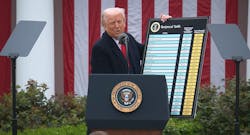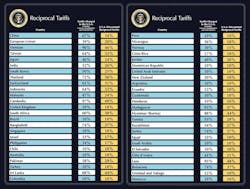Key takeaways:
- President Trump signed an executive order implementing tariffs on all U.S. imports
- The order charges U.S. companies for at least 10% of the value of anything they import.
- Automobile and auto parts imports face a 25% tariff, and imports from key trading partners face tariffs from 20% to 49%.
- The import taxes will likely raise prices and reduce freight demand.
President Donald Trump signed an executive order implementing sweeping tariffs on nearly all imports on Wednesday afternoon.
The U.S. will impose a baseline duty tax of 10% on all imports, with some exemptions, beginning April 5. On April 9, Trump will impose varying duties on imports from 57 specific countries as much as 49%. In his speech from the White House Rose Garden, Trump said he is imposing a 25% tariff on all foreign-made automobiles (excluding heavy-duty trucks), which was announced on March 26 and took effect April 3.
The baseline 10% tariff has key exemptions for copper, pharmaceuticals, semiconductors, lumber articles, bullion, energy, and “other certain minerals that are not available in the United States.” The complete list of exemptions under Trump’s latest tariffs includes over 900 articles under the Harmonized Tariff Schedule of US codes.
If the country-specific tariffs take effect April 9, they would raise duties beyond the baseline 10% for 57 countries based on factors like trade deficits.
“This is one of the most important days, in my opinion, in American history. It is a declaration of economic independence,” Trump said. “With today’s action, we are finally going to be able to make America great again, greater than ever before.”
The tariffs will have significant repercussions for the U.S. economy and the health of the trucking industry.
During his announcement of the tariffs, Trump displayed a chart outlining some of the most prominent countries targeted by specific April 9 duties. The new tariffs include a 20% ad valorem duty on imports from the European Union, 32% on imports from Taiwan, 24% on Japan, and more.
Major blow to freight demand
Earlier this year, analysts predicted national freight demand would grow moderately throughout the year. However, market paralysis and tariffs have damaged that optimism. Industries affected by the tariffs, directly or indirectly, will likely have weaker freight demand.
The American Trucking Associations issued gentle criticism in response to the news.
“Notably, today’s announcement excluded additional tariffs on Canada and Mexico, a welcome reprieve as it relates to cross-border freight,” ATA’s president and CEO Chris Spear said in a note to association members. “That said, the tariffs announced today have potential to depress freight volumes and increase equipment costs for our industry. We continue to express these concerns directly to Administration officials. Our team is currently poring over the details of today’s announcement, and we’ll be assessing its impact on motor carriers and our supplier partners.”
Meanwhile, Uber Freight noted that the tariffs could damage manufacturing's productivity.
“Tariffs add cost pressures to an already fragile manufacturing sector. Supply chain executives are signaling concerns that higher trade barriers will lead to reduced production, job cuts, and rising inflation,” Mazen Danaf, senior economist for Uber Freight, said. “The latest Purchasing Managers Index (PMI) data confirms a slowdown, with manufacturing output and new orders declining. Meanwhile, the cost of raw materials is surging—March saw price increases across all major industries surveyed. These signals suggest that businesses are bracing for economic headwinds, reinforcing how critical it is to maintain supply chain resilience in an uncertain environment.”
See also: Now is not the time to be average
On the bright side, recent freight demand still exceeded expectations. Shippers are expediting freight and building inventories ahead of tariff threats. Orders for manufactured goods unexpectedly rose in February, according to Reuters. The buildup raised spot rates for some routes and moved peak shipping seasons earlier.
"Over the weekend and leading up to the tariff announcement, we saw an extraordinary volume of trucks moving northbound from Mexico into the U.S., particularly along the IH35 corridor,” Jose Guerrero, director of U.S. Customs Operations for Uber Freight, said. “Some importers held back shipments until the news was confirmed, while others rushed to move goods ahead of potential disruptions. This pattern suggests shippers are closely monitoring trade policy and adjusting their strategies in real time.”
However, the spike in pre-tariff demand is likely temporary.
“As we’ve been telling people for months now: what goes up is going to come down,” Avery Vise, VP of trucking for FTR Transportation Intelligence, told FleetOwner in March. “Any surge you get due to the tariffs is going to be offset because the reason for doing that is to build inventories.”
Uncertainty demolishes economic confidence
Market sentiment in the face of tariffs has been poor. Consumer confidence plummeted for several months in a row. Most major stock market index values are down year to date, marking one of the worst quarters for the market since 2022.
“Everybody we talk to—whether it’s equipment buyers, dealers, suppliers, OEMs, leasing companies—there’s almost a sense of paralysis in the marketplace,” Ken Vieth president ACT Research told FleetOwner in a recent Market Pulse video. “You can’t make a good business decision in a vacuum.”
Half of FleetOwner readers in March disapproved of Trump’s performance as president, due in part to tariffs: 55% of respondents felt negative about his performance. Meanwhile, 10% felt neutral and 34% felt positive. Trump’s critics in the survey frequently mentioned tariff uncertainty.
“Nobody likes this level of volatility,” Dean Croke, principal analyst for DAT Freight & Analytics, told FleetOwner in March. “That’s what I think most of us are concerned about: that all of this market volatility just means that any chance of the market recovery in the second half of the year has kind of disappeared.”
Retaliatory tariffs so far
Canada previously issued 25% tariffs on $40 billion USD worth of goods, including U.S. metals, adhesives, tires, household objects, ceramics, agricultural products, and more. Canada also threatened an additional $85 billion USD in tariffs if trade conflicts continue.
China previously imposed 10-15% tariffs on U.S. agricultural products and fossil fuels. The country has threatened further tariffs against U.S. metals exports.
The European Union threatened to impose duties ranging from 4.4% to 50% on over $25 billion in goods, including U.S. agricultural products, metals, fabrics, and more.
What is the harm in tariffs?
The supporting argument for tariffs is that, theoretically, protectionist taxes would eventually strengthen domestic economic activity and insulate key industries from global politics. If true, tariff policy could improve domestic freight demand after several years.
However, historical, sweeping protectionist tariffs have a mixed record in the U.S.
The two greatest tariff spikes in the nation’s history took place around 1830 with the Tariff of Abominations (and its subsequent tariff plans) and 1930 with the Smoot-Hawley Act. Both spikes led to political tension, depressed international trade, and spiking domestic prices. Particularly harmful were other countries’ retaliatory tariffs, which often damaged U.S. agricultural exports. The Smoot-Hawley Act infamously prolonged the Great Depression.
“The people who support tariffs think that this will lead to greater domestic production—and yes, if that were to happen, we would see a big benefit for trucking,” FTR’s Vise said in March. “But the things that have to fall into place for that to happen are almost fanciful. They just aren’t going to happen … It’s likely that the overall picture is going to be just more expensive products, which are likely to depress demand.”
In today’s global economy, tariffs on fundamental materials like metals likely have long-lasting negative effects. Recent trade research of Bush-era tariffs found that even precisely planned, short-term duties can depress downstream industries’ trade relationships for a decade or more. Once tariffs motivate countries to reconfigure their global trade, the damage is slow to reverse.
About the Author
Jeremy Wolfe
Editor
Editor Jeremy Wolfe joined the FleetOwner team in February 2024. He graduated from the University of Wisconsin-Stevens Point with majors in English and Philosophy. He previously served as Editor for Endeavor Business Media's Water Group publications.



